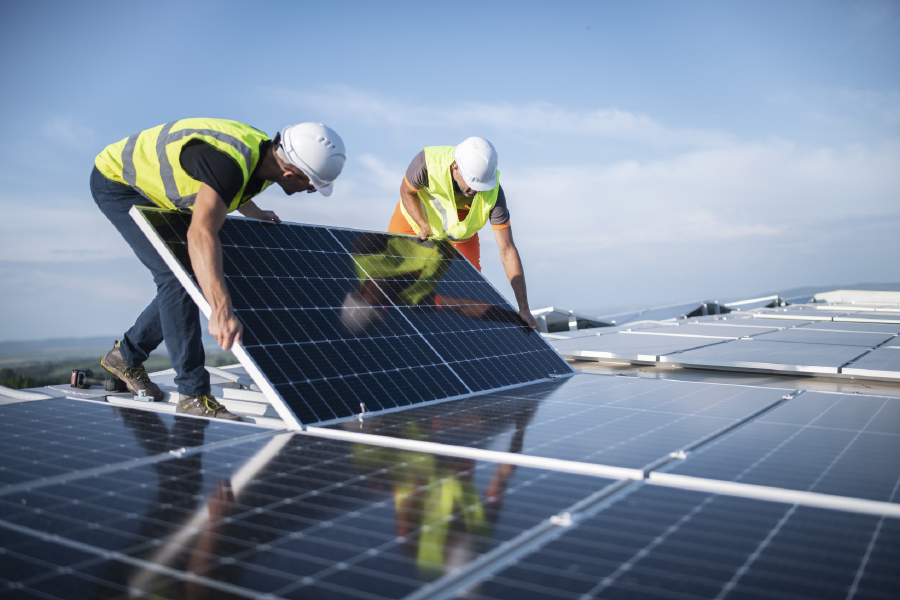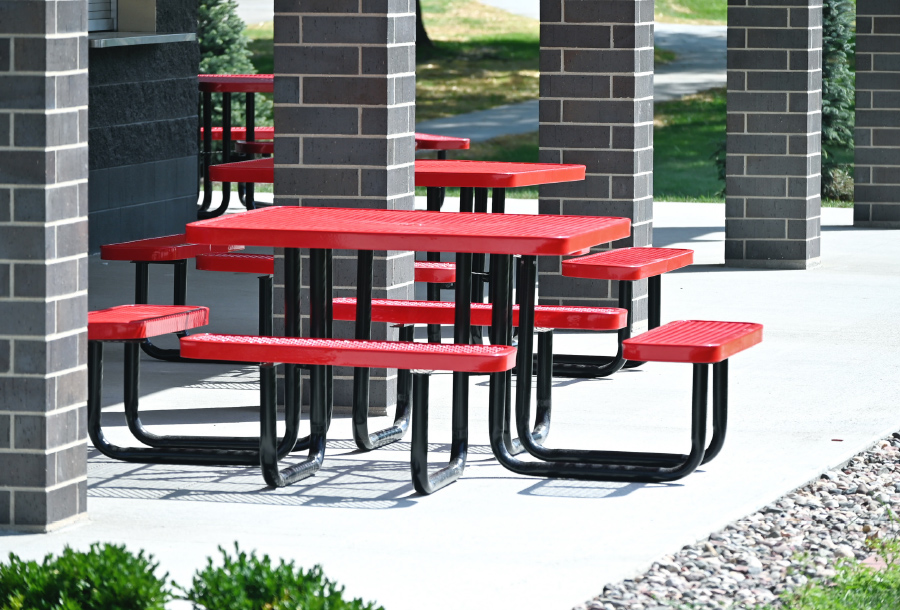
After school and on weekends, Oxnard Union High School District in Southern California’s Ventura County, like many local educational agencies, has traditionally lent its facilities for use by area youth and adult sports teams as well as for community meetings or service events.
“[The pandemic] brought more of a focus and reminded us how vital our facilities are to our communities, families and students,” said school Oxnard Union HSD Board Vice President Elizabeth Botello. “When we were closed for COVID, we still kept getting calls weekly about wanting our facilities to open to support the community.”
o safely reopen for in-person activities, school leaders in California and around the nation had to make infrastructure updates, some of which, like improvements to ventilation and air quality, were likely needed far prior to the public health crisis. Yet, due to factors including underfunding, officials are often forced to leave repairs and updates on the backburner.
According to the Public Policy Institute of California’s summer 2020 report Improving K–12 School Facilities in California, 38 percent of K-12 students in the state go to a school with at least one deficiency.
PPIC considered results of Facility Inspection Tool (FIT) evaluations that schools in California are required to report each year in their School Accountability Report Cards. However, because the evaluation only involves a visual inspection, the data it produces may underestimate a schools’ facility needs, the report notes.
FIT categories include cleanliness, electrical, external, interior surfaces, restrooms and fountains, safety, structural and systems (e.g. heating, ventilation, air conditioning or HVAC).
PPIC found that schools in suburban areas or small towns have higher rates of deficiencies than those in city or rural areas, possibly because of differences in local wealth, spending or management, among other factors.
At the national level, 2020 findings from the U.S. Government Accountability Office show that upgrades to HVAC systems, interior lighting fixtures, roofing, and safety and security mechanisms were widely needed. Forty-one percent of school districts needed to upgrade or replace the HVAC systems on at least half of their campuses.
A recent CSBA report, Beyond the Spreadsheets: Insights from California education leaders on utilizing COVID-19 relief funding, highlights the extraordinary efforts that LEAs have made to address the many priorities they continue to face in dealing with the impacts of the pandemic. It includes the results of a wide-ranging survey of superintendents and LEA fiscal staff that focused on education leaders’ priorities, challenges and recommendations for using state and federal COVID relief funds Respondents representing LEAs that serve more than 1.3 million K-12 students across California participated in the survey.


The majority of respondents also indicated they had been at least moderately impacted by supply chain constraints. Forty-eight percent of respondents said their district had experienced substantial or extreme impacts to their ability to use COVID relief funds because of supply chain constraints related to construction and/or maintenance materials.
Porterville Unified School District, located in Tulare County, has experienced challenges while trying to improve its HVAC system due to equipment delays and issues with production and delivery, according to Brad Rohrbach, assistant superintendent of Business Services. They’re prioritizing projects like this as they know the deadline to use COVID relief is looming.
In the meantime, the district deployed standalone air purification units in classrooms for the return to school and is now getting replacement filters for its 1,000 units to help “supplement indoor air quality until a more permanent solution is in place.”
Porterville USD also received California Schools Healthy Air, Plumbing, and Efficiency Program (CalSHAPE) funding for HVAC and plumbing improvements, but Rohrbach said that Elementary and Secondary School Emergency Relief (ESSER) dollars are more restricted and time sensitive so the district plans to use those funds first.
Ultimately, they’d like to have a system in place that can monitor CO2 levels, humidity levels and energy usage as well as monitor outdoor air quality in order to adjust intake levels if necessary.

as of fall 2022 at www.csba.org/COVID_Relief_Spending
Kimberly De Serpa, the district’s school board president, said they’ve also used ESSER dollars to update roofing, and almost every school site received upgrades or repairs to their HVAC systems. With rising temperatures, the district would like to install air conditioning in all of its classrooms, but that would require an additional $18 million, De Serpa said.
Using fiscal data from U.S. districts, the 2021 State of our Schools: America’s PK-12 public school facilities report by the 21st Century School Fund, the International WELL Building Institute and the National Council on School Facilities found that “the gap between expenditures and good stewardship of buildings and grounds is growing significantly. [The report] estimates that our nation is now underinvesting in school buildings and grounds by $85 billion each year, up an inflation-adjusted $25 billion a year since 2016.”
The average age of public schools around the nation was 44 years in 2012, according to the 2021 State of our Schools report. In California, 30 percent of schools were built 50 or more years ago, and 10 percent were constructed more than 70 years ago, according to the PPIC’s Improving K–12 School Facilities in California report.
Statewide estimates included in PPIC’s report indicate that school districts need to spend between $3.1 and $4.1 billion annually to maintain their current facilities. Over the next decade, $100 billion is estimated to be needed to perform maintenance and modernization as well as new construction.
A January 2022 report by the California State Auditor estimated that in the next five years, $7.4 billion in additional funds will need to be provided by the state to meet “existing and anticipated modernization funding requests.”
According to PPIC’s March 2022 report Equitable State Funding for School Facilities, state and local bonds are what fund most school construction and facility improvement projects in California. Oxnard Union HSD’s Botello pointed out how difficult getting a local bond passed can be when surrounding districts are pursuing them too or when the community has been paying into multiple bonds already.
The state’s School Facility Program (SFP) provides funding too, though the report notes that some believe “that the SFP’s local matching-funds requirement and first-come, first-served approach privilege wealthier districts with greater administrative capacity.” Funding for the SFP comes from voter-approved statewide general obligation bonds, which can be difficult to rely on due to their uncertainty. The 2016 bond will likely be exhausted in 2022–23, and a 2020 bond that would have pushed $15 billion in SFP funding was not approved by voters.
CSBA Legislative Advocate Cheryl Ide said that a means of long-term, ongoing funding at the state level is an issue that needs to be addressed.
“While it may give others some pause for when we have economic downturns, bonds consistently tend to be a place to look toward for strength and building up workforce such as the construction industry and other labor industry groups,” Ide said.
Security is also top of mind for many LEAs as they pursue projects including upgrading fencing, installing cameras and securing lobbies.
Oxnard Union HSD is opening a new school, Del Sol High, in the 2023–24 academic year to alleviate overcrowding in its existing high schools. Its construction was paid for by a 2004 school bond.
While the new campus will surely have all the essentials for modern times, the district’s oldest campus, Oxnard High School, dates back to 1901. Located near the Pacific Ocean, some of the district’s older schools were built without air conditioning, which has been addressed in recent years as heat waves made it a necessity.
Along with regulating the air temperature, controlling air quality, as observed in Porterville USD, is becoming increasingly important and beneficial across the state for virus mitigation and an added layer of protection against wildfire smoke, an element Californians have become far too familiar with in recent years. Having the best, and safest, facilities possible is critical for student success. It also could be a tool for educator retention amid a teacher shortage.


—Kimberly De Serpa, board president, Pajaro USD
Districts are also readying to bring a new population of students onto campuses in coming years by expanding early learning offerings, as the state continues the push to make transitional kindergarten universally available by 2025–26.
“We have several full-day [kindergarten programs] at our district that we’ve rolled out in preparation. We like to do things ahead of state mandates and so we’ve been putting in portables on some of our campuses,” De Serpa said. “We’ve also had a reduction in the number of kids enrolled. We went from almost 22,000 to 18,500, so there has been a decline and we’ve been able to utilize other classrooms or combine classrooms. I know it’s a challenge for many school districts, though, to find the space.”
In addition to finding space, finding money to implement the facilities changes necessary for new programs like universal TK can be difficult without state support.
CSBA’s Ide noted the inconsistency in public messaging from state agencies. “Giving money for teachers, but not giving them a classroom is a concern,” said Ide. “While some districts might have the ability to make adjustments for classrooms, that doesn’t mean it’s an appropriate classroom, especially when it comes to our younger students in TK.”
While the district has been able to complete projects like installing solar technology, it can’t currently pursue all the projects it would like to, and is expected to, under an existing school bond. For example, due to skyrocketing costs, the completion of a performing arts center at Pajaro Valley High School was delayed.
“We’ve always been cautious with money. We have the highest total compensation of any district in our area [in] benefits and salaries. We’re always trying to figure out ways to enhance our facilities but also save money if we can,” De Serpa said. “That’s one of the reasons we put a priority on solar. Anytime we can get matching dollars for things we can do to save money over the long-term duration, we do that.”
In the organization’s Equitable State Funding for School Facilities report, PPIC pondered how the state could improve the equity and efficiency of facilities funding. Recommendations included improving equity in state capital funding allocations, for modernization in particular; improving data collection and reporting around the condition of facilities; consider mandating that districts draft facility master plans; and having the state and counties provide technical assistance to help districts that have fewer resources apply for and receive SFP funds.
CSBA was disappointed to see in the Governor’s January Budget Proposal the delay to 2025–26 of $550 million in one-time General Fund monies to assist in creating appropriate TK facilities. CSBA Governmental Relations staff will continue to advocate for allowing LEAs to access 100 percent state funding until districts can pass local bonds. “This additional funding and flexibility will be critical to ensuring that LEAs can fulfill the state’s goals for TK expansion and serve their new students,” Ide said.
Heather Kemp is a staff writer for California Schools.